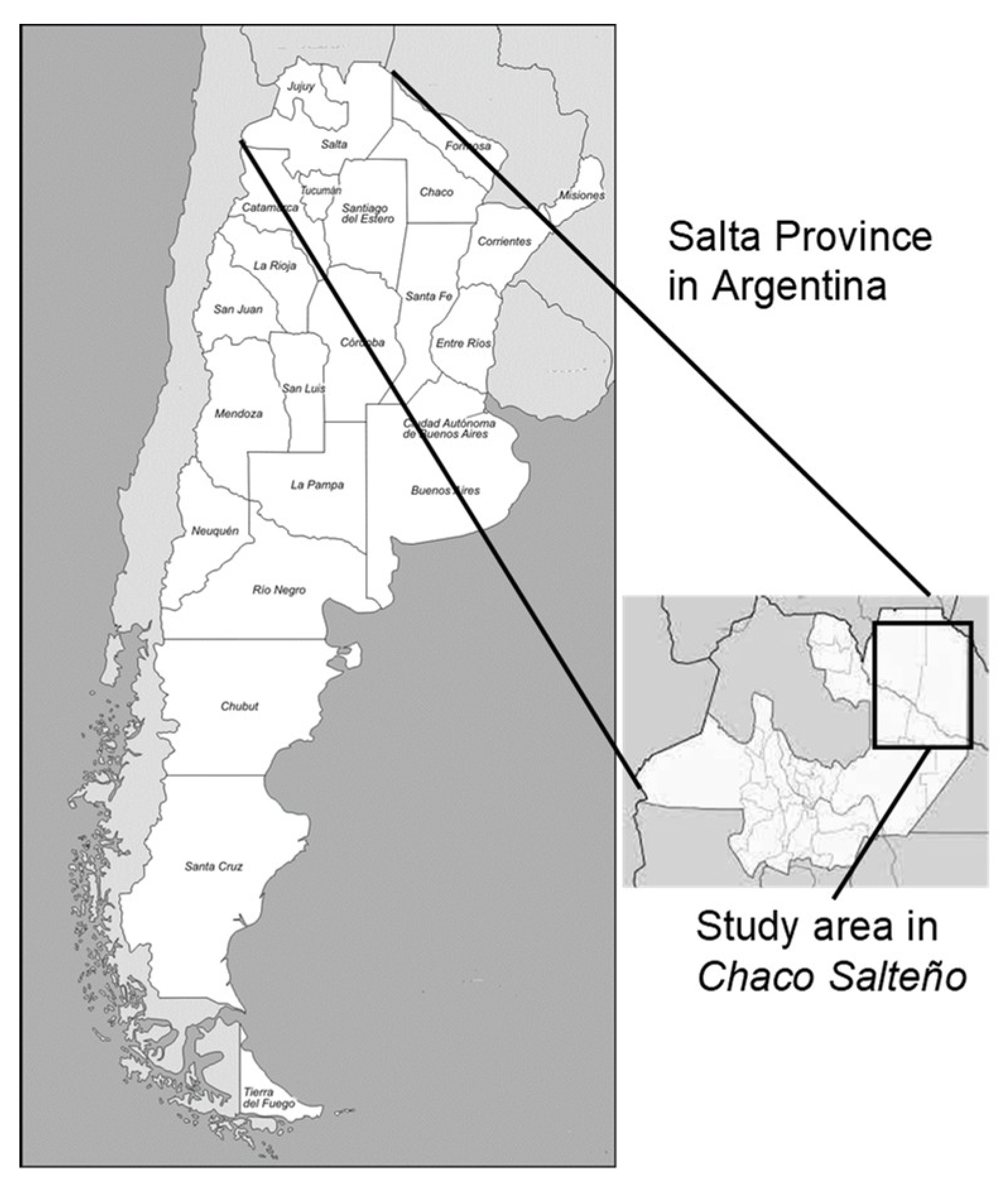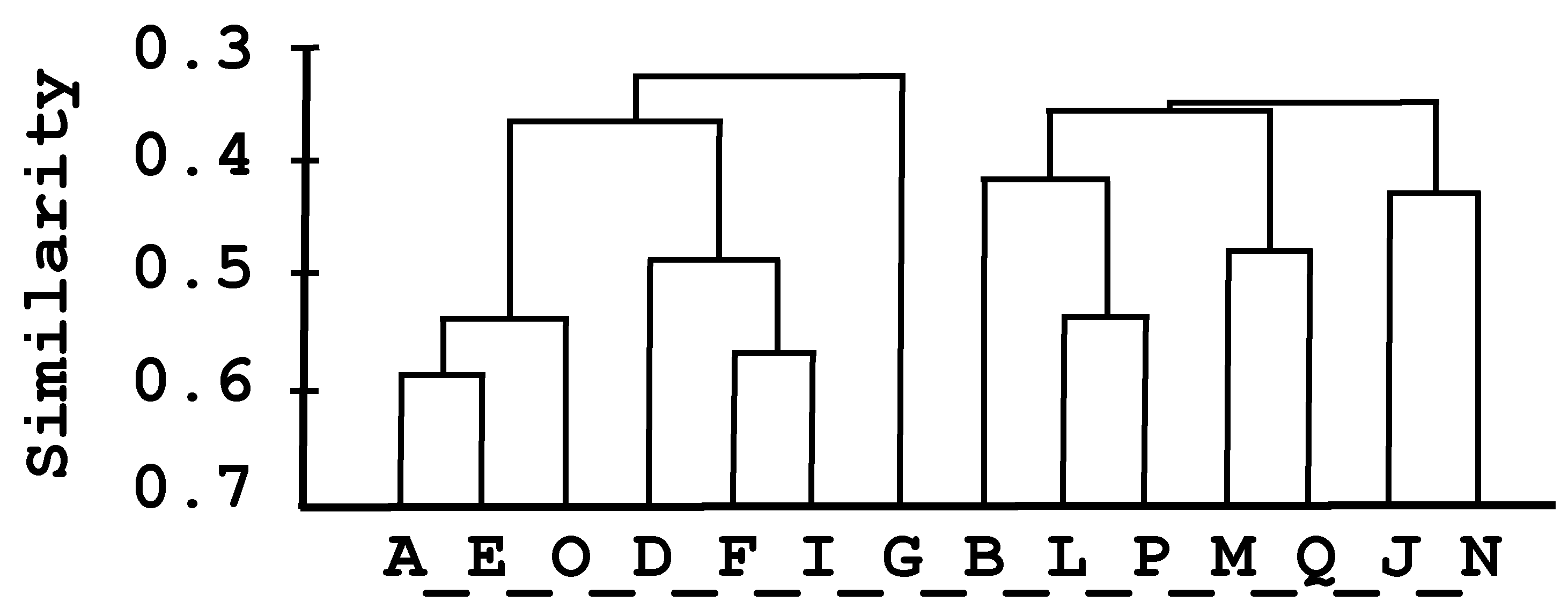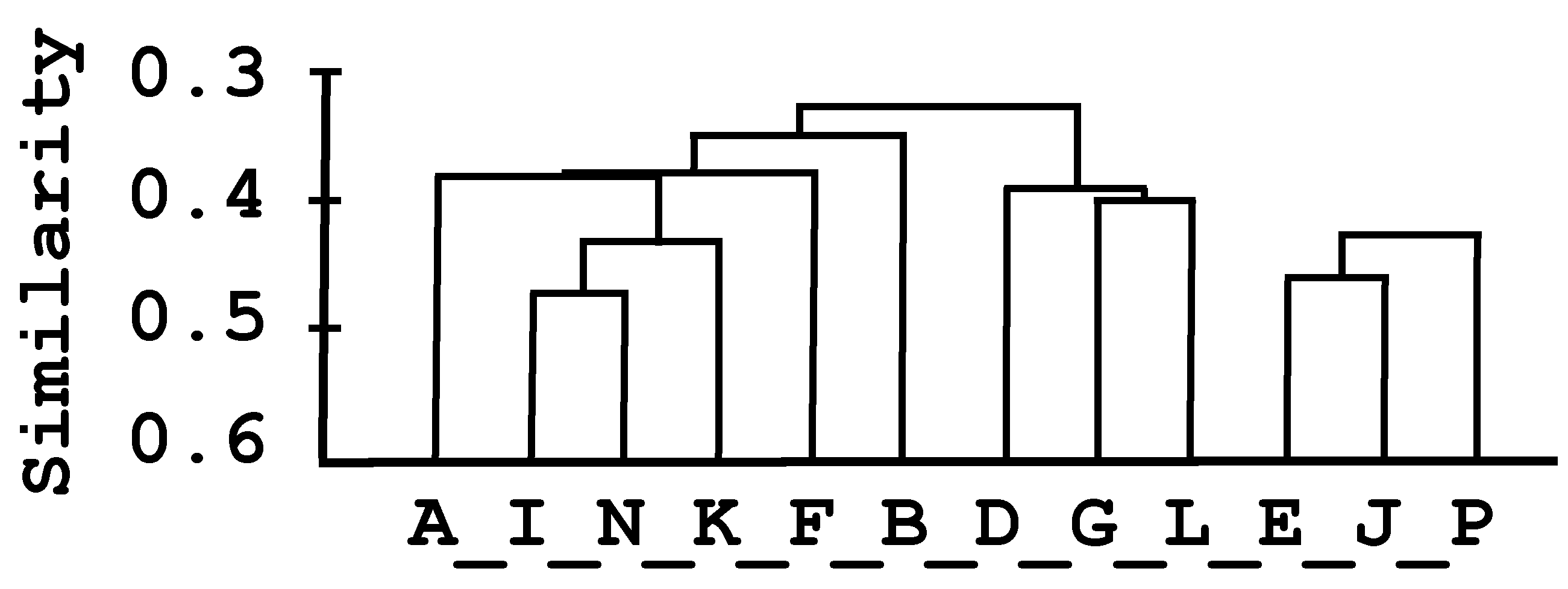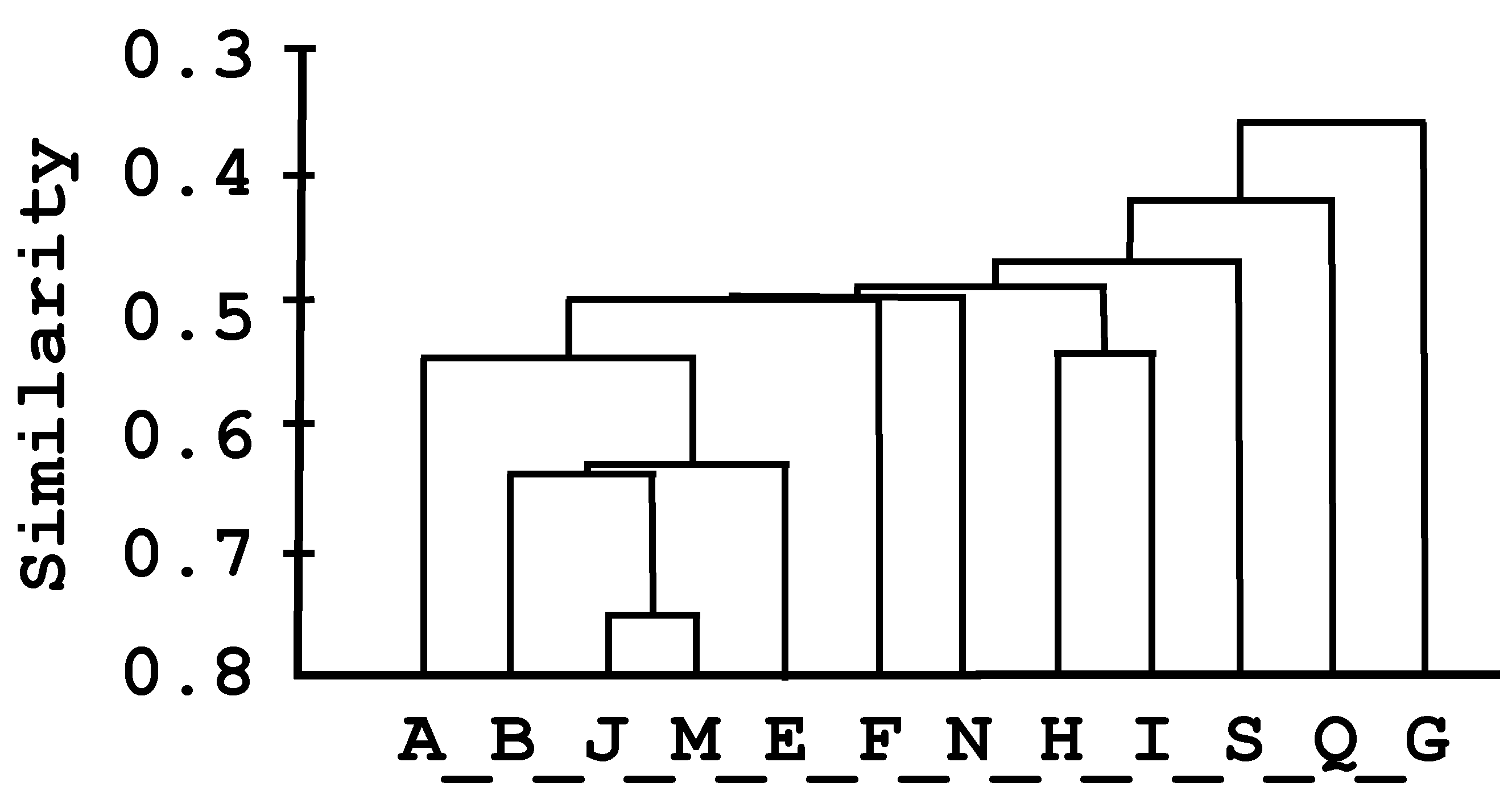An Analytical Approach to Assess the Influence of Expert Panel Answer on Decision Making: The Case of Sustainable Land Use in Ribadavia Banda Norte, Salta (Argentina)
Abstract
1. Introduction
2. Materials and Methods
2.1. The Study Area
2.2. Survey for an Expert Panel
2.3. Selection of Expert Panel
2.4. Concordance Matrix and Dendrograms
- Find the greatest element sij (elements with higher similitude).
- Merge elements i and j into a single new cluster.
- Calculate a new set of distances defined as the minimum distance (maximum similitude) between the new cluster and the remaining elements.
- Repeat steps 1–3 until a single group contains all elements (in step >1, the element could be clusters derived from the previous agglomeration).
2.5. Discrete MCDA Method
3. Results
3.1. Survey
3.2. Dendrograms
3.2.1. Precision Agriculture: Technique 1
3.2.2. Forest with Integrated Livestock: Technique 2
3.2.3. Payment for Ecosystem Services: Technique 3
3.2.4. Traditional Agriculture-Livestock Farming—Criollo: Technique 4
3.2.5. Traditional Forest Management—Wichi: Technique 5
3.3. Discrete MCDA Results
4. Discussion
5. Conclusions
Supplementary Materials
Author Contributions
Funding
Institutional Review Board Statement
Informed Consent Statement
Data Availability Statement
Conflicts of Interest
Appendix A
- Q1
- Land tenure security
- Q2
- Purchase, sale, rental, and loan of land for housing; commercial production; or large-scale agricultural production
- Q3
- Provision of potable and irrigation water, enough for both activities
- Q4
- Availability of drainage to prevent flooding
- Q5
- Access to energy (electricity and gas) and connection to telecommunications and internet services
- Q6
- Availability of product storage services and fuel supply
- Q7
- Availability of machinery, spare parts, repairs, and supplies for agricultural production
- Q8
- Access to transport services at affordable prices for products
- Q9
- Food sovereignty
- Q10
- Food security
- Q11
- Generation of sources of employment, income, livelihoods
- Q12
- Capacity for savings, financing, insurance, reinvestment in housing, and production
- Q13
- Tolerance and acceptance between different social groups
- Q14
- Agropecuary landscape
- Q15
- Conservation of protected areas
- Q16
- Air quality (increase or decrease in air pollution)
- Q17
- Soil quality and productive capacity
- Q18
- Land use efficiency
- Q19
- Surface and groundwater quality
- Q20
- Efficient management and use of water
- Q21
- Renewable and non-renewable energy sources
- Q22
- Ecosystems and their regulatory capacity
- Q23
- Ecosystem resilience
- Q24
- Natural flora and fauna
- Q25
- Surplus value or prices of the land destined for agricultural production or another production system
- Q26
- Agricultural production
- Q27
- Livestock production
- Q28
- Forestry production
- Q29
- Tourism production
- Q30
- Quality of life or good living conditions of the people
- Q31
- Cultural/spiritual values.
Appendix B
| ELECTRE | ||||||||||||||||
| Equal | +Sustainable | +Economical | +Ecologic | |||||||||||||
| V-AC | V-AD | V-BC | V-BD | V-AC | V-AD | V-BC | V-BD | V-AC | V-AD | V-BC | V-BD | V-AC | V-AD | V-BC | V-BD | |
| 1st | T2 | T3 | T2 | T3 | T2 | T3 | T2 | T3 | T2 | T3 | T2 | T3 | T2 | T3 | T2 | T3 |
| 2nd | T3 | T2 | T3 | T2 | T3 | T2 | T3 | T2 | T3 | T2 | T3 | T2 | T3 | T2 | T3 | T2 |
| 3th | T1 | T1 | T4 | T4 | T1 | T1 | T4 | T4 | T1 | T1 | T1 | T1 | T1 | T1 | T4 | T4 |
| 4th | T4 | T4 | T1 | T1 | T4 | T4 | T1 | T1 | T4 | T4 | T4 | T4 | T4 | T4 | T1 | T1 |
| 5th | T5 | T5 | T5 | T5 | T5 | T5 | T5 | T5 | T5 | T5 | T5 | T5 | T5 | T5 | T5 | T5 |
| AHP | ||||||||||||||||
| Equal | +Sustainable | +Economical | +Ecologic | |||||||||||||
| V-AC | V-AD | V-BC | V-BD | V-AC | V-AD | V-BC | V-BD | V-AC | V-AD | V-BC | V-BD | V-AC | V-AD | V-BC | V-BD | |
| 1st | T2 | T3 | T2 | T3 | T2 | T3 | T2 | T3 | T2 | T3 | T2 | T3 | T3 | T3 | T3 | T3 |
| 2nd | T3 | T1 | T3 | T2 | T3 | T2 | T3 | T2 | T3 | T2 | T3 | T2 | T2 | T1 | T2 | T2 |
| 3th | T1 | T2 | T4 | T4 | T1 | T1 | T4 | T4 | T1 | T1 | T4 | T4 | T1 | T2 | T4 | T4 |
| 4th | T4 | T4 | T1 | T1 | T4 | T4 | T1 | T1 | T4 | T4 | T1 | T1 | T4 | T4 | T1 | T1 |
| 5th | T5 | T5 | T5 | T5 | T5 | T5 | T5 | T5 | T5 | T5 | T5 | T5 | T5 | T5 | T5 | T5 |
References
- Wackernagel, M.; Yount, J.D. The ecological footprint: An indicator of progress toward regional sustainability. Environ. Monit. Assess. 1998, 51, 511–529. [Google Scholar] [CrossRef]
- Vasileiou, K.; Morris, J. The sustainability of the supply chain for fresh potatoes in Britain. Supply Chain Manag. Int. J. 2006, 11, 317–327. [Google Scholar] [CrossRef]
- Paolasso, P.; Krapovickas, J.; Gasparri, N.I. Deforestación, expansión agropecuaria y dinámica demográfica en el Chaco Seco Argentino durante la década de los noventa. Lat. Am. Res. Rev. 2012, 47, 35–63. [Google Scholar] [CrossRef]
- Quintero-Angel, M.; González-Acevedo, A. Tendencies and challenges for the assessment of agricultural sustainability. Agric. Ecosyst. Environ. 2018, 254, 273–281. [Google Scholar] [CrossRef]
- Guzmán, E.S. Sobre los Orígenes de la Agroecología en el Pensamiento Marxista y Libertario; Centre for Development and Environment: La Paz, Bolivia, 2011; ISBN 9995413477. [Google Scholar]
- Paul, M.; Negahban-Azar, M.; Shirmohammadi, A.; Montas, H. Assessment of agricultural land suitability for irrigation with reclaimed water using geospatial multi-criteria decision analysis. Agric. Water Manag. 2020, 231, 105987. [Google Scholar] [CrossRef]
- Pérez, J.C.; Carrillo, M.H.; Montoya-Torres, J.R. Multi-criteria approaches for urban passenger transport systems: A literature review. Ann. Oper. Res. 2015, 226, 69–87. [Google Scholar] [CrossRef]
- Diaz-Balteiro, L.; González-Pachón, J.; Romero, C. Measuring systems sustainability with multi-criteria methods: A critical review. Eur. J. Oper. Res. 2017, 258, 607–616. [Google Scholar] [CrossRef]
- Wang, J.-J.; Jing, Y.-Y.; Zhang, C.-F.; Zhao, J.-H. Review on multi-criteria decision analysis aid in sustainable energy decision-making. Renew. Sustain. Energy Rev. 2009, 13, 2263–2278. [Google Scholar] [CrossRef]
- Arondel, C.; Girardin, P. Sorting cropping systems on the basis of their impact on groundwater quality. Eur. J. Oper. Res. 2000, 127, 467–482. [Google Scholar] [CrossRef]
- Halog, A.; Manik, Y. Advancing integrated systems modelling framework for life cycle sustainability assessment. Sustainability 2011, 3, 469–499. [Google Scholar] [CrossRef]
- Deytieux, V.; Munier-Jolain, N.; Caneill, J. Assessing the sustainability of cropping systems in single-and multi-site studies. A review of methods. Eur. J. Agron. 2016, 72, 107–126. [Google Scholar] [CrossRef]
- Antón, J.M.; Grau, J.B.; Cisneros, J.M.; Tarquis, A.M.; Laguna, F.V.; Cantero, J.J.; Andina, D.; Sánchez, E. Discrete multi-criteria methods for lands use and conservation planning on La Colacha in Arroyos Menores (Río Cuarto, Province of Córdoba, Argentina). Ann. Oper. Res. 2016, 245, 315–336. [Google Scholar] [CrossRef]
- Grau, J.B.; Antón, J.M.; Tarquis, A.M.; Colombo, F.; de los Ríos, L.; Cisneros, J.M. An application of mathematical models to select the optimal alternative for an integral plan to desertification and erosion control (Chaco Area–Salta Province–Argentina). Biogeosciences 2010, 7, 3421–3433. [Google Scholar] [CrossRef]
- Kuhnert, P.M.; Martin, T.G.; Griffiths, S.P. A guide to eliciting and using expert knowledge in Bayesian ecological models. Ecol. Lett. 2010, 13, 900–914. [Google Scholar] [CrossRef]
- Van Calker, K.J.; Berentsen, P.B.M.; Giesen, G.W.J.; Huirne, R.B.M. Identifying and ranking attributes that determine sustainability in Dutch dairy farming. Agric. Hum. Values 2005, 22, 53–63. [Google Scholar] [CrossRef]
- Craheix, D.; Angevin, F.; Doré, T.; De Tourdonnet, S. Using a multicriteria assessment model to evaluate the sustainability of conservation agriculture at the cropping system level in France. Eur. J. Agron. 2016, 76, 75–86. [Google Scholar] [CrossRef]
- Yousuf, M.I. Using expertsopinions through Delphi technique. Pract. Assess. Res. Eval. 2007, 12, 4. [Google Scholar]
- Wentholt, M.T.A.; Rowe, G.; König, A.; Marvin, H.J.P.; Frewer, L.J. The views of key stakeholders on an evolving food risk governance framework: Results from a Delphi study. Food Policy 2009, 34, 539–548. [Google Scholar] [CrossRef]
- Frewer, L.J.; Fischer, A.R.H.; Wentholt, M.T.A.; Marvin, H.J.P.; Ooms, B.W.; Coles, D.; Rowe, G. The use of Delphi methodology in agrifood policy development: Some lessons learned. Technol. Forecast. Soc. Change 2011, 78, 1514–1525. [Google Scholar] [CrossRef]
- Wolfe, W.S.; Frongillo, E.A. Building household food-security measurement tools from the ground up. Food Nutr. Bull. 2001, 22, 5–12. [Google Scholar] [CrossRef]
- Jellason, N.P.; Baines, R.N.; Conway, J.S. A Delphi Approach to the Selection of Good Agricultural Practices (GAPs) for Resilience Enhancement for Dry Land Farmers in North-Western Nigeria. J. Food Sci. Eng. 2017, 7, 383–395. [Google Scholar] [CrossRef][Green Version]
- Kendall, H.; Kaptan, G.; Stewart, G.; Grainger, M.; Kuznesof, S.; Naughton, P.; Clark, B.; Hubbard, C.; Raley, M.; Marvin, H.J.P. Drivers of existing and emerging food safety risks: Expert opinion regarding multiple impacts. Food Control 2018, 90, 440–458. [Google Scholar] [CrossRef]
- Moragues-Faus, A.; Sonnino, R.; Marsden, T. Exploring European food system vulnerabilities: Towards integrated food security governance. Environ. Sci. Policy 2017, 75, 184–215. [Google Scholar] [CrossRef]
- Etxeberria, I.A.; Garayar, A.; Sánchez, J.A.C. Development of sustainability reports for farming operations in the Basque Country using the Delphi method. Rev. Contab. 2015, 18, 44–54. [Google Scholar] [CrossRef]
- Mokarram, M.; Mokarram, M.J.; Gitizadeh, M.; Niknam, T.; Aghaei, J. A novel optimal placing of solar farms utilizing multi-criteria decision-making (MCDA) and feature selection. J. Clean. Prod. 2020, 261, 121098. [Google Scholar] [CrossRef]
- Alemdar, K.D.; Kaya, Ö.; Çodur, M.Y. A GIS and microsimulation-based MCDA approach for evaluation of pedestrian crossings. Accid. Anal. Prev. 2020, 148, 105771. [Google Scholar] [CrossRef] [PubMed]
- Chen, L.; van Westen, C.J.; Hussin, H.; Ciurean, R.L.; Turkington, T.; Chavarro-Rincon, D.; Shrestha, D.P. Integrating expert opinion with modelling for quantitative multi-hazard risk assessment in the Eastern Italian Alps. Geomorphology 2016, 273, 150–167. [Google Scholar] [CrossRef]
- Kamali, F.P.; Borges, J.A.R.; Meuwissen, M.P.M.; de Boer, I.J.M.; Lansink, A.G.J.M.O. Sustainability assessment of agricultural systems: The validity of expert opinion and robustness of a multi-criteria analysis. Agric. Syst. 2017, 157, 118–128. [Google Scholar] [CrossRef]
- Mardani, A.; Zavadskas, E.K.; Khalifah, Z.; Zakuan, N.; Jusoh, A.; Nor, K.M.; Khoshnoudi, M. A review of multi-criteria decision-making applications to solve energy management problems: Two decades from 1995 to 2015. Renew. Sustain. Energy Rev. 2017, 71, 216–256. [Google Scholar] [CrossRef]
- Wang, Z.; Ren, J.; Goodsite, M.E.; Xu, G. Waste-to-energy, municipal solid waste treatment, and best available technology: Comprehensive evaluation by an interval-valued fuzzy multi-criteria decision making method. J. Clean. Prod. 2018, 172, 887–899. [Google Scholar] [CrossRef]
- Gobierno de la Provincia de Salta. Anuario Estadistico. Año 2016; Gobierno de la Provincia de Salta, Ed.: Salta, Argentina, 2017; ISBN 978-987-46491-1-9.
- Álvarez Leguizamón, S. Geopolítica nacional, estructura social y racismo. In Estudios Sobre la Estructural Social en la Argentina Contemporánea; Álvarez Leguizamón, S., Arias, A.J., Terra Muñiz, L., Eds.; CLACSO: Buenos Aires, Argentina, 2016; pp. 333–389. ISBN 978-987-722-222-7. [Google Scholar]
- Leake, A.; López, O.; Leake, M.C. La Deforestación del Chaco Salteño 2004–2015; SMA Ediciones: Salta, Argentina, 2016. [Google Scholar]
- Ravina, N.M. Evaluación del Impacto Económico de Tecnologías Apropiadas para Pequeños Productores Ganaderos del Chaco Semiárido Salteño; Universidad de Buenos Aires: Buenos Aires, Argentina, 2006. [Google Scholar]
- García, E.; Flego, F. Agricultura de precisión. Rev. Cienc. y Tecnol. Recuper. 2008. Available online: https://www.palermo.edu/ingenieria/downloads/pdfwebc&T8/8CyT12.pdf (accessed on 11 June 2021).
- Pathak, H.S.; Brown, P.; Best, T. A systematic literature review of the factors affecting the precision agriculture adoption process. Precis. Agric. 2019, 20, 1292–1316. [Google Scholar] [CrossRef]
- Alaggia, F.G.; Cabello, M.J.; Carranza, C.; Cavallero, L.; Daniele, G.; Erro Velazquez, M.; Ledesma, M.; Lopez, D.R.; Mussat, E.; Navall, J.M. Manual de Indicadores para Monitoreo de Planes Prediales para el Manejo de Bosques con Ganadería Integrada (MBGI) Región Parque Chaqueño; INTA: Buenos Aires, Argentina, 2019. Available online: https://repositorio.inta.gob.ar/xmlui/handle/20.500.12123/9046 (accessed on 11 June 2021).
- Sarmiento, M.; Rios, N.A. Factibilidad de implementación de un esquema de pagos por servicios ambientales en la cuenca Los Pericos-Manantiales, Jujuy, Argentina. Quebracho-Rev. Cienc. For. 2009, 17, 64–76. [Google Scholar]
- Núñez-Regueiro, M.M.; Hiller, J.; Branch, L.C.; Godoy, C.N.; Siddiqui, S.; Volante, J.; Soto, J.R. Policy lessons from spatiotemporal enrollment patterns of payment for ecosystem service programs in Argentina. Land Use Policy 2020, 95, 104596. [Google Scholar] [CrossRef]
- Córdoba, G.S.; Camardelli, M.C. Transformación del paisaje cultural en la región del Chaco semiárido de la provincia de Salta en el siglo XXI. 2017. Available online: https://ri.conicet.gov.ar/handle/11336/66716 (accessed on 11 June 2021).
- Montani, R. La etnicidad de las cosas entre los wichís del Gran Chaco (provincia de Salta, Argentina). Indiana 2008, 25, 117–142. [Google Scholar]
- Gualotuña-Parra, J.A. La Aplicación de la Agricultura de Precisión Como Herramienta Económica para el Desarrollo Sostenible en el Territorio del Chaco Salteño. Master’s Thesis, Universidad Católica de Salta, Salta, Argentina, 2015. [Google Scholar]
- Allen, I.E.; Seaman, C.A. Likert scales and data analyses. Qual. Prog. 2007, 40, 64–65. [Google Scholar]
- Scheele, D.S. Reality Construction as a Product of Delphi Interaction. In The Delphi Method: Techniques and Applications; Linstone, H., Turoff, M., Eds.; Addison-Wesley: Boston, MA, USA, 2002; pp. 35–67. [Google Scholar]
- Makkonen, M.; Hujala, T.; Uusivuori, J. Policy experts’ propensity to change their opinion along Delphi rounds. Technol. Forecast. Soc. Change 2016, 109, 61–68. [Google Scholar] [CrossRef]
- Siegel, S. Castellan. Nonparametric Statistics for the Social Sciences; McGraw-Hill: New York, NY, USA, 1988. [Google Scholar]
- Knight, W.R. A computer method for calculating Kendall’s tau with ungrouped data. J. Am. Stat. Assoc. 1966, 61, 436–439. [Google Scholar] [CrossRef]
- Hartigan, J.A. Clustering Algorithms; John Wiley & Sons, Inc.: Hoboken, NJ, USA, 1975; ISBN 047135645X. [Google Scholar]
- Wang, C.; Hao, C.; Guan, X. Hierarchical and overlapping social circle identification in ego networks based on link clustering. Neurocomputing 2020, 381, 322–335. [Google Scholar] [CrossRef]
- Degen, B.; Blanc-Jolivet, C.; Stierand, K.; Gillet, E. A nearest neighbour approach by genetic distance to the assignment of individual trees to geographic origin. Forensic Sci. Int. Genet. 2017, 27, 132–141. [Google Scholar] [CrossRef]
- Diaz-Balteiro, L.; González-Pachón, J.; Romero, C. Sustainability as a multi-criteria concept: New developments and applications. Sustainability 2020, 12, 7527. [Google Scholar] [CrossRef]
- Roy, B. Classement et choix en présence de points de vue multiples. Rev. Française D’Informatique Rech. Opérationnelle 1968, 2, 57–75. [Google Scholar] [CrossRef]
- Romero, C. Teoría de la Decisión Multicriterio: Conceptos, Técnicas y Aplicaciones; Alianza: Madrid, España, 1993; ISBN 842068144X. [Google Scholar]
- Grau, J.B.; Anton, J.M.; Tarquis, A.M.; Andina, D. Election of water resources management entity using a multi-criteria decision (MCD) method in Salta province (Argentine). J. Syst. Cybern. Informatics 2009, 7, 1–7. [Google Scholar]
- Derak, M.; Cortina, J. Multi-criteria participative evaluation of Pinus halepensis plantations in a semiarid area of southeast Spain. Ecol. Indic. 2014, 43, 56–68. [Google Scholar] [CrossRef]
- Adem Esmail, B.; Geneletti, D. Multi-criteria decision analysis for nature conservation: A review of 20 years of applications. Methods Ecol. Evol. 2018, 9, 42–53. [Google Scholar] [CrossRef]
- Gong, Q.; Yang, H. Balance of opinions in expert panels. Econ. Lett. 2018, 170, 151–154. [Google Scholar] [CrossRef]
- Dicks, L.V.; Wright, H.L.; Ashpole, J.E.; Hutchison, J.; McCormack, C.G.; Livoreil, B.; Zulka, K.P.; Sutherland, W.J. What works in conservation? Using expert assessment of summarised evidence to identify practices that enhance natural pest control in agriculture. Biodivers. Conserv. 2016, 25, 1383–1399. [Google Scholar] [CrossRef] [PubMed]
- Hegelund, L.; Sørensen, J.T. Developing a HACCP-like system for improving animal health and welfare in organic egg production–based on an expert panel analysis. Animal 2007, 1, 1018–1025. [Google Scholar] [CrossRef][Green Version]
- Hagerhall, C.M. Consensus in landscape preference judgements. J. Environ. Psychol. 2001, 21, 83–92. [Google Scholar] [CrossRef]
- Haara, A.; Store, R.; Leskinen, P. Analyzing uncertainties and estimating priorities of landscape sensitivity based on expert opinions. Landsc. Urban Plan. 2017, 163, 56–66. [Google Scholar] [CrossRef]
- Mashizi, A.K.; Escobedo, F.J. Socio-ecological assessment of threats to semi-arid rangeland habitat in Iran using spatial models and actor group opinions. J. Arid Environ. 2020, 177, 104136. [Google Scholar] [CrossRef]
- Ortiz-Urbina, E.; González-Pachón, J.; Diaz-Balteiro, L. Decision-making in forestry: A review of the hybridisation of multiple criteria and group decision-making methods. Forests 2019, 10, 375. [Google Scholar] [CrossRef]






| Techniques | Advantages | Disadvantages |
|---|---|---|
| Precision agriculture [36,37] |
|
|
| Integrated agroforestry [38] |
|
|
| Payment for ecosystem services [39,40] |
|
|
| Traditional agriculture-livestock farming—criollo [41] |
|
|
| Traditional forest management—wichi [42] |
|
|
| Bad Impact | Non | Good Impact | |||||||||
|---|---|---|---|---|---|---|---|---|---|---|---|
| Scale | 1 | 2 | 3 | 4 | 5 | 6 | 7 | 8 | 9 | 10 | 11 |
| Score | 5 | 4 | 3 | 2 | 1 | 0 | 1 | 2 | 3 | 4 | 5 |
| Code | The Institution They Belong to | Type |
|---|---|---|
| A | Catholic University of Salta (UCASAL)—Environmental law—Professor. | University |
| B | Prograno Association. | Producer Association |
| C | Association. Social Integration of the Agricultural and Forestry Sector in the Chaco region of Salta (ISFACSA). | NGO |
| D | Institute of Environmental Law and Sustainability—(IDEAS, UCASAL)—Staff. | University |
| E | Secretariat of Environment and Sustainable Development of the Nation, Argentina. | Government—Environmental |
| F | Sustainable use of biodiversity project UNDP ARG15/G53 (Livestock)—Staff. | International organization—Environmental |
| G | TEPEYAC, a non-profit civil association, is part of the Diocese’s aboriginal pastoral of the New Oran. | NGO (aboriginal) |
| H | Catholic University of Salta (UCASAL), Law—Professor. | University |
| I | National Institute of Agricultural Technology (INTA)—Staff. | Research (government) |
| J | Eco-enterprises. | Producer Association (ecology) |
| K | Independent Producer. | Producer (independent) |
| L | National Institute of Agricultural Technology (INTA). Animal health, ecophysiology. | Research (government) |
| M | Secretariat of Family Agriculture. | Government—Family agriculture |
| N | Catholic University of Salta (UCASAL)—Professor | University |
| O | National Institute of Agricultural Technology (INTA). | Research (government) |
| P | Sustainable use of biodiversity project UNDP ARG15/G53 (Livestock)—Technician. | International organization—Environmental |
| Q | Fundapaz—Staff. | NGO (aboriginal and family) |
| S | National Institute of Agricultural Technology (INTA)—Natural Resources and Environment | Research (government) |
| CRIT | CG1 | CG2 | CG3 | CG4 | CG5 | |
|---|---|---|---|---|---|---|
| TÉC | ||||||
| T1 | 6.706 | 6.239 | 5.884 | 6.388 | 6.407 | |
| T1-A | 6.848 | 6.853 | 7.667 | 6.767 | 7.917 | |
| T1-B | 6.509 | 5.382 | 4.029 | 6.094 | 5.077 | |
| T2 | 7.560 | 7.871 | 7.199 | 7.730 | 7.450 | |
| T2-C | 7.813 | 8.317 | 8.400 | 8.214 | 8.353 | |
| T2-D | 7.571 | 6.929 | 4.667 | 7.462 | 5.500 | |
| T3 | 7.578 | 7.966 | 8.992 | 7.508 | 9.174 | |
| T4 | 6.245 | 7.150 | 4.087 | 5.407 | 7.000 | |
| T5 | 5.411 | 5.419 | 3.548 | 4.086 | 4.375 | |
| V-AC | V-AD | V-BC | V-BD | V | |
|---|---|---|---|---|---|
| 1st | T2 | T3 | T2 | T3 | T3 |
| 2nd | T3 | T2 | T3 | T2 | T2 |
| 3th | T1 | T1 | T4 | T4 | T1 |
| 4th | T4 | T4 | T1 | T1 | T4 |
| 5th | T5 | T5 | T5 | T5 | T5 |
Publisher’s Note: MDPI stays neutral with regard to jurisdictional claims in published maps and institutional affiliations. |
© 2021 by the authors. Licensee MDPI, Basel, Switzerland. This article is an open access article distributed under the terms and conditions of the Creative Commons Attribution (CC BY) license (https://creativecommons.org/licenses/by/4.0/).
Share and Cite
Gualotuña Parra, J.A.; Tarquis, A.M.; Grau Olivé, J.B.; Colombo Speroni, F.; Saa-Requejo, A. An Analytical Approach to Assess the Influence of Expert Panel Answer on Decision Making: The Case of Sustainable Land Use in Ribadavia Banda Norte, Salta (Argentina). Sustainability 2021, 13, 6705. https://doi.org/10.3390/su13126705
Gualotuña Parra JA, Tarquis AM, Grau Olivé JB, Colombo Speroni F, Saa-Requejo A. An Analytical Approach to Assess the Influence of Expert Panel Answer on Decision Making: The Case of Sustainable Land Use in Ribadavia Banda Norte, Salta (Argentina). Sustainability. 2021; 13(12):6705. https://doi.org/10.3390/su13126705
Chicago/Turabian StyleGualotuña Parra, José Alex, Ana M. Tarquis, Juan B. Grau Olivé, Federico Colombo Speroni, and Antonio Saa-Requejo. 2021. "An Analytical Approach to Assess the Influence of Expert Panel Answer on Decision Making: The Case of Sustainable Land Use in Ribadavia Banda Norte, Salta (Argentina)" Sustainability 13, no. 12: 6705. https://doi.org/10.3390/su13126705
APA StyleGualotuña Parra, J. A., Tarquis, A. M., Grau Olivé, J. B., Colombo Speroni, F., & Saa-Requejo, A. (2021). An Analytical Approach to Assess the Influence of Expert Panel Answer on Decision Making: The Case of Sustainable Land Use in Ribadavia Banda Norte, Salta (Argentina). Sustainability, 13(12), 6705. https://doi.org/10.3390/su13126705








